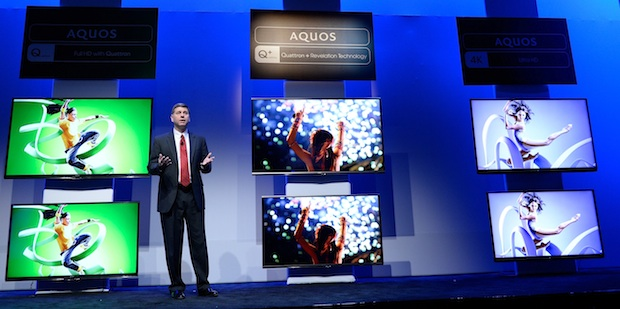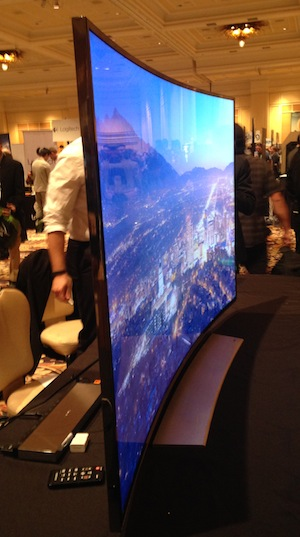
Photo: Tekla Perry One of Samsung's new curved TVs
 Press day, the day before the official opening of the International Consumer Electronics Show (CES), always brings new product and technology announcements from the large TV manufacturers—LG, Panasonic, Sony, Sharp, Samsung, and, a more recent entry into the pre-CES fray, Hisense. With so many companies strutting their latest stuff in just a few hours, trends quickly emerge.
Press day, the day before the official opening of the International Consumer Electronics Show (CES), always brings new product and technology announcements from the large TV manufacturers—LG, Panasonic, Sony, Sharp, Samsung, and, a more recent entry into the pre-CES fray, Hisense. With so many companies strutting their latest stuff in just a few hours, trends quickly emerge.
My biggest takeaway from yesterday is that 2014 is just not going to be the year of the TV. Several of the big TV manufacturers actually spent much of their announcement time on wearables (more on that trend later in the week) or their entries into what we used to call home automation, but now call the Internet of Things. It's clear that even the TV manufacturers think consumers will be spending their money on these gadgets, not on a new TV. And that makes sense—according to the Consumer Electronics Association, 98%, of American households have a TV, and the average household has 2.9 of them. The vast majority of us have flat HDTVs that are as large as we really can fit in our homes, and have all sorts of smarts we don't even use; we won't be rushing out to replace them anytime soon.
That said, the manufacturers are certainly still looking for that magic technology that will be so cool, so compelling that it will instantly make our current TVs obsolete. And they all seem to be trying the same approaches:
Ultra High Definition (UHD), which includes higher 4K resolution, better color depth, and improved sound
This new format provides a crystal clear picture, and makes TVs, some say, look like a window. Sharp trotted out endorsements from directors who talked about the fact that more detail lets them capture more subtle emotions. One hurdle for 4K TVs is their price—today, the premium for 4K over a comparable HDTV set is about US $3000. Another hurdle is lack of content, but Netflix announced at the show that it would be streaming "House of Cards" in 4K, and will start producing all its original shows in the format. Finally, there's the bandwidth issue—more pixels on the screen means more data to transmit, and with streaming rapidly overtaking disc-based media, telling folks to go out and by a 4K disc and player isn't going to cut it. But Netflix had more good news on that front: it announced 4K streaming support, and said streaming will even work at bitrates under 15 Mbps. Comcast's Xfinity on Demand will be upgraded to support 4K as well, and Samsung said it's working with Direct TV to include streaming in 4K. And one manufacturer, Panasonic, is taking what seems to me a very sensible approach—they're not worrying about consumer 4K at this point, but rather pushing the format for business use, in situations where the extra resolution has a demonstrable benefit, such as in security systems, signage, and displays in museums and galleries.
Curving the Screen
LG, Samsung, and Panasonic all unveiled curved screen TVs at the show. They're particularly pushing the curve in the larger screen sizes, those that are well over 100 inches. The manufacturers say a curved screen is more immersive and provides better viewing angles, but I'm skeptically wondering if it's just a way to convince the folks that want the biggest TV their house will hold that they can fit a bigger TV without needing a bigger wall. Samsung and LG also introduced flexible TVs that convert from flat to curved.
New Operating Systems for Smart TV
Developments in this area are going to be really interesting to watch over the next couple of years. And yes, I say couple of years because I think it's going to take that long for the manufacturers to figure it out. TV controls today are a mess. Smart TVs that attempt to bring together streaming media, regular television, and web browsing tend to be both confusing and frustrating. You can't really operate them with a basic TV remote—but should you really need a computer keyboard or a mobile device to use your TV?
The TV manufacturers are taking on the challenge. LG, which last year acquired WebOS, the operating system developed by Palm, announced that it would be using that technology as its smart TV platform. Sharp developed their Smart Central system internally, as did Panasonic with its Life+ and Hisense with Vidaa. I'll try these over the next few days and will report back, but I'm guessing none are perfect yet. And the problem won't really be fixed until we have a standard system as familiar as the old TV dial—you should be able to easily operate a TV over at a friend's house. Today, too often, you can't.
That's what's hot. The pre-CES announcements also showed what is not hot: OLED and 3-D. LG and Samsung were all about OLED at last year's CES; this year, they barely mentioned the technology (though they will still be making some TV models available in OLED). In fact, LG's first mention of OLED was as a screen for a fitness band. And 3-D, which just a few years ago was supposed to be the savior of the TV industry, is also being ignored as much as possible. The exception is glasses-free TVs—one coapany, Izon, says it will have three models on the market by the second quarter of this year, but the technology still seems to be more a proof of concept at this point than a viable mass-market product.





